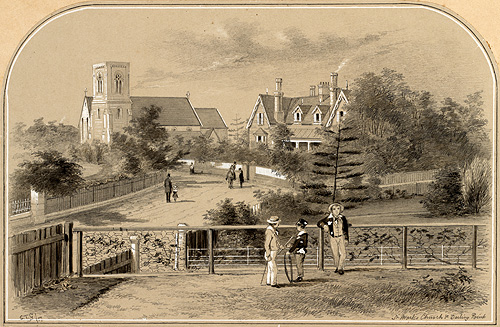Community
Darling Point was a small close-knit community, with a small number of families living in the area during the 1850s – 1880s. Many families intermarried and close friendships developed amongst residents. Most were also members of St. Mark's Church, which became a focal point for the community. Church on Sunday was also the day for meeting and gossip about the week's events. Conversations moved from gardens to business and families to politics.

St Mark's Church and Darling Point, 1857, by S. T. Gill
Pencil and ink drawing. Pd 95
Both Thomas Sutcliffe Mort and Thomas Ware Smart, whose properties bordered St. Mark's, allowed the public to walk through their gardens to church on Sunday, chatting to friends before the service. This public-mindedness also extended to their private art collections which they opened to the public on regular occasions. "These art treasures were collected not so much for the adornment of a noble mansion, or indeed in any respect for selfish ostentations display, as for the purpose of entertaining and improving the tastes of (their) fellow colonists..." it was reported at the time.
St. Mark's Church, which opened for worship in 1852, was built on land originally given by Thomas Sutcliffe Mort and local parishioners continued to contribute to the church's development. The close-knit congregation comprised various members of Darling Point society including the Nortons of Ecclesbourne, the Mitchells of Carthona, the Bradleys of Lindesay, the Tooths of Brooksby, the Horderns of Retford Hall. St. Mark's has always been a popular and fashionable venue for society weddings, for both Darling Point residents and Sydney's aspiring social set.


